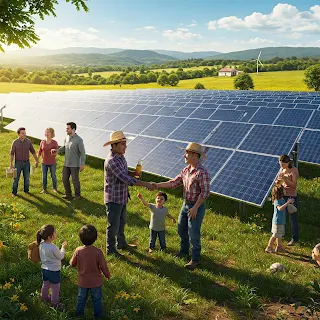Solar energy is no longer just a luxury for wealthy homeowners or large corporations. Thanks to the rise of solar cooperatives (co-ops) and community solar projects, more people—including renters, low-income households, and small businesses—can now access clean, affordable energy.
This movement is transforming how we think about energy equity, local empowerment, and sustainable living.
In this article, we’ll dive deep into:
What solar co-ops and community solar are
How they work
Their impact on energy accessibility
Challenges and solutions
Real-world examples
Future trends
Let’s explore how collective power is lighting the path to a greener future.
What Are Solar Co-Ops and Community Solar Projects?
🌱 Understanding Solar Co-Ops
A solar cooperative (solar co-op) is a group of individuals or businesses that join forces to negotiate better terms for solar panel installation. By pooling their buying power, members can access:
Lower prices for panels and installation
Higher-quality equipment
Trusted local contractors
Expert advice
It's similar to buying wholesale—you get better rates because you’re purchasing collectively rather than individually.
☀️ What Is Community Solar?
Community solar refers to a shared solar energy project where multiple participants benefit from a single solar array. Instead of installing solar panels on your own property, you subscribe to a portion of a large, centralized solar farm.
Benefits include:
Receiving a credit on your electricity bill
No need for rooftop space
Access for renters and apartment dwellers
No maintenance worries
Why Accessibility Matters in the Solar Movement
Solar adoption traditionally required significant upfront costs and homeownership—barriers for millions.
Energy justice demands that clean energy solutions are available to everyone, regardless of:
Income level
Housing situation
Geographic location
Solar co-ops and community solar directly address these inequalities by lowering costs, increasing access, and fostering local engagement.
How Solar Co-Ops Make Solar Affordable
1. Bulk Purchasing Power
Solar co-ops leverage group buying to negotiate 20-30% discounts compared to market rates.
2. Quality Assurance
Since the group selects trusted contractors through a competitive bidding process, participants enjoy higher installation quality and warranties.
3. Simplified Process
Navigating permits, system designs, and financing options can be overwhelming. Co-ops provide education sessions and personalized support, simplifying the journey.
4. Democratizing Solar
Every member—regardless of technical knowledge—has a voice in vendor selection and project planning, making the process more transparent and inclusive.
How Community Solar Breaks Barriers
1. Zero Installation Needed
Participants subscribe to a share of a solar farm and offset their utility bills without installing anything at home.
2. Serving Renters and Condo Owners
Community solar removes property ownership as a requirement, opening access to:
Apartment dwellers
Multi-family housing residents
Small businesses
3. Flexible Subscription Models
Many programs offer:
No long-term contracts
Pay-as-you-go options
Low-income subscriptions with enhanced benefits
4. Strengthening Local Economies
Community solar projects often:
Hire local labor
Stimulate local businesses
Retain energy spending within communities
Success Stories: Solar Access in Action
🔥 Solar United Neighbors (SUN)
Nationwide nonprofit organizing neighborhood-based solar co-ops.
Over 7,000+ installations completed.
Participants save an average of $5,000 on system costs.
🔥 Arcadia Power
Community solar platform allowing users nationwide to connect to local solar projects.
Offers 100% renewable energy access even if you can't install panels.
🔥 Colorado’s Community Solar Gardens
Colorado pioneered the Community Solar Gardens Act (2010).
By 2023, over 150 MW of community solar was operational, mainly benefiting low- to moderate-income households.
Challenges Facing Solar Co-Ops and Community Solar
🏗️ 1. Complex Regulation
Energy policies vary widely by state and utility, complicating project development.
💸 2. Financing Hurdles
Securing funding for initial infrastructure costs can be difficult without government support or incentives.
🧩 3. Awareness and Education
Many consumers still don’t know community solar exists or how to participate.
🔋 4. Grid Interconnection Issues
Integrating large solar projects into aging grid infrastructure can be technically challenging and expensive.
Solutions and Policy Support
🏛️ Stronger State Legislation
States like New York, Minnesota, and Colorado have passed community solar-friendly laws that:
Simplify project approvals
Mandate utility cooperation
Offer incentives for low-income participation
🎓 Education and Outreach
Organizations like Solar United Neighbors and Vote Solar are increasing awareness through:
Community meetings
Online platforms
Advocacy campaigns
🏦 Innovative Financing Models
New models include:
Pay-as-you-go
Sliding scale subscription fees
Federal incentives under the Inflation Reduction Act
The Future of Solar Access: Trends to Watch
1. Virtual Power Plants (VPPs)
Community solar arrays linked with battery storage could operate as virtual power plants, stabilizing the grid during peak demand.
2. Blockchain Energy Trading
Emerging platforms allow peer-to-peer energy sharing among subscribers, making the system decentralized and efficient.
3. AI Optimization
Artificial intelligence can predict energy demand, optimize load distribution, and maximize community solar output.
4. Low-Income Targeting
Future policies aim to ensure that at least 40% of new solar benefits go to underserved and frontline communities.
Conclusion: Collective Power for a Cleaner Future
Solar co-ops and community solar projects aren’t just technical innovations—they're social innovations.
By bringing people together, they’re breaking down barriers to renewable energy and democratizing access to a cleaner, greener future.
Whether you’re a homeowner, a renter, or a small business owner, the solar revolution is no longer out of reach.
The sun shines for everyone—and now, with collective action, so can solar power.

No comments:
Post a Comment